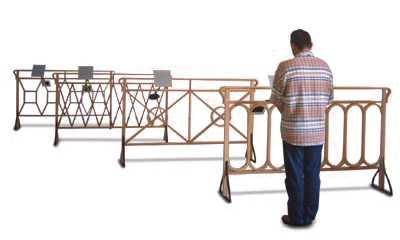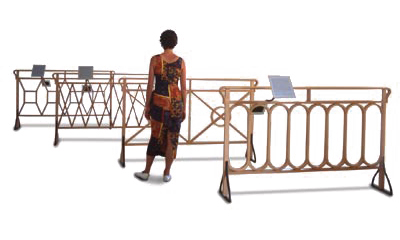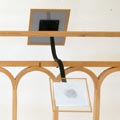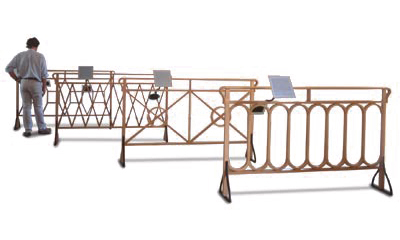The barriers


On the evening of September 13, 1921, bored with waiting within the confines of the four walls of his seventh floor apartment, Oskar Serti went to stand on the landing to look out for the arrival of Catherine de Sélys in stairway B which lead to his home.
Each time he heard the main door of the building open, Serti trembled at the idea of finally seeing Catherine appear at the foot of the steps; but without fail the footsteps went on up the steps of staircase A or C.
After an hour of waiting, he tapped the cigarette that was burning in his nervous fingers, saying to himself that if Catherine did not arrive before the little cylindrical block of ash reached the ground floor, alwl of his illusions would be shattered.
Unfortunately, during its fall, the ash broke up in the air and not a single piece touched the floor.
Serti was then seized by the fear that nothing could take form in the stairwell; footsteps, ash, everything evaporated. At one point, pushed on by the wish to finally see something important happen, he felt the urge to throw himself over this balustrade to be crushed against the floor below.
But as he should have expected, this idea evaporated as quickly as it had come to him.
Opposite side : doodle by Oskar Serti on a table cloth at the “Vieille Barrière” restaurant, drawn whilst he was telling the story recounted above to some journalists.


On the 3rd October, 1921, when he was finishing his study of Marble Sculpture in Canada, Oskar Serti visited a sculpture workshop in the Academy of Fine Arts in Toronto. So as not to disturb the pupils in their work, he sat on the small balcony which overlooked the main workshop from a height of thirty feet and gave him a perfect overall view.
He discovered amongst the blocks which the students were sculpting, a bust whose lines - still barely begun - awoke the vibrant image of Catherine de Sélys within him. Serti felt so deeply moved by this rough sketch that he had to cling to this balustrade to prevent himself from falling. For several months he had dreamed of writing a letter to Catherine which would reveal to her how he really felt, and here, finally, through the simple presence of this bust - the right words came to him. He seized his notebook so as to get them on paper as quickly as he could. The resemblance to Catherine had been purely accidental, and from one moment to the next it was disappearing under the blows of the chisel that was trying to shape the chubby features of the model seated at the centre of the studio.
Unfortunately, Serti uncapped his pen so briskly that all the ink spilled out before he had written even a single word. He was so disappointed that he did not notice the sculpture student transfixed thirty feet below: he had just cut into the marble where it showed a little veining, when he saw a long stream of blue flowing from the incision and at once lost all desire to continue cutting the stone.
Opposite side : doodle produced by Oskar Serti on a table cloth in the Courtyard Cafe whilst telling the story reported above to friends.


On May 5 1921, Oskar Serti dropped a one franc coin into the basin of the Townsquare’s fountain making the wish that he might see Catherine de Sélys again. As the coin touched the bottom, it shone with such brilliance that he began to hope the impossible would happen. Then little by little, the water grew murky and the coin disappeared in a cloud of mud. Although Oskar bent double over this balustrade, all he could see was the surface of the water, where, as the ripples moved, the reflection of his body was thrown against the rocks.
Suddenly he saw a turtle’s head emerging from the basin, it too seemed to be searching for the coin. Oskar realised that the poor beast was attracted by anything that shone. As soon as someone threw a coin into the fountain it wanted to get close to it, but the movement of its feet stirred up the murky depths of the water and prevented it from reaching its goal.
Serti stared at the turtle as if to tell it just how much he shared in its misfortune; but it sank back into the water without even noticing him, and Oskar realised that his grievous disappointments must have caused his eyes to lose their brilliance.
On the other side : doodle by Oskar Serti on a tablecloth in the restaurant “A la Poule d’Or”, as he was telling himself the story recounted above.


Upon discovering that Catherine de Sélys was to give piano recitals at the “Salle Pleyel” during the month of June, 1921, Oskar Serti immediately reserved a front row seat in the dress circle for each evening.
On June 29, a few minutes from the end of the penultimate performance, Oskar Serti heard Catherine’s playing reach such heights of feeling that he leaned far out over the ledge of this balustrade to be closer to the keyboard. Then he saw, falling from his pocket, the ticket meant for the concert of the following evening; his last chance to see Catherine fell away from him. First his ticket spiralled downwards, then - probably carried by the heat of the lights - it was lifted up into the air.
Serti had wanted to concentrate on the last notes of Catherine’s piece, but his eyes desperately followed the flight of his ticket as if the key to Catherine’s musical immortality were vanishing before him. A gust of air - certainly caused by an open door in the wings - carried it towards the stage. It hovered above Catherine’s head and then fell onto the keyboard.
Catherine de Sélys was so surprised at seeing a small piece of blue paper appear on the keys that, for a fraction of a second, she lost her concentration and for the first time in her young career she played a wrong note in public. Despite the fact that the prolonged applause which accompanied the end of her performance did not seem to begrudge her this one mistake, she was so mortified by it that she thought she would have to cancel the performance the next day.
Opposite side : doodle by Oskar Serti on a tablecloth in the restaurant “Chez Lucienne”, as he told the story recounted above to the other diners.
